Sustainable Accessibility: A Mobile App for Helping People with Disabilities to Search Accessible Shops
Abstract
1. Introduction
2. Materials and Methods
2.1. Definition of the Accessibility Levels
- Level A. This level corresponds to accessible buildings. This category includes entrances at street level without any obstacles. Small obstacles that can be easily overcome by all users are also tolerated: a step with a maximum of 1 cm, or a ramp with a slope up to 8%.
- Level B. This level contains the buildings which are accessible with a low or moderate difficulty by most users. This situation occurs when the access is done through a ramp with a slope of 10% or less. A maximum slope of 25% is allowed for small heights of 5 cm or less.
- Level C. This level refers to the buildings whose entry is practicable with the help of other people. According to the experience of the users, some help is needed when the ramps have a slope greater than 10% and up to 12%, or a step up to 12 cm in height. This level includes steps up to 12 cm with a ramp of less than 30% slope. Finally, this category also includes entries with a step of less than 3 cm of height, but with a rounded border.
- Level D. The rest of the cases are included in this level D, which contains all the buildings which are considered as not accessible. This means that buildings with a ramp of more than 12% slope or a step higher than 12 cm are not accessible by people with reduced mobility under common circumstances.
2.2. Collection of Accessibility Information
- Analysis and distribution of the geographical areas of the zone under study, and schedule of visits to the establishments. The study took place over a period of 8 months, from December 2017 to July 2018, and it involved three technicians.
- Visit to the shops to check out their accessibility. The technical staff measured parameters such as the number and height of the steps, the length and slope of the ramps, the width of the entrance, and the type of door handle. Other parameters of interest, that are indicated in the following sections, such as the name of the shop, the type of activity, and the GPS location, were also collected. Photographs were taken of the public part of the buildings, avoiding the appearance of people.
- Preparation of a summary table showing the levels of accessibility of all the establishments studied, indicating the characteristics of the entrance, the type of door, whether or not it has stairs, ramps, and any other information which can be relevant for people with disabilities. This table also contains the geographical location of the buildings, using GPS coordinates, the type and subtype of the establishment, and the date of the last visit. This information is used to create the database of the app.
3. A Sustainable Mobile Application for Finding Accessible Shops
3.1. Analysis and Selection of Technological Alternatives
3.2. Requirements Specification
- SRS1. The application shall display the following details of the establishments: name, address, GPS coordinates, type, subtype, accessibility level, the description of the entries, specific description of the doors and ramps in the access to the shop, the opening time, toilet, comments, the date of registration and the last modification date.
- SRS2. The establishments are divided into types and subtypes. Possible types are: food; restaurant industry; education; health; aesthetics and personal care; textile and accessories; leisure and entertainment; banks, insurance and management; real estate; home and decoration; technology; automotive; others. Each type group has its own subtype classification.
- SRS3. The application shall provide the following actions: search an establishment, sign in, log in, send suggestions, view user’s suggestions, rate establishments, manage establishments, and delete users.
- SRS4. There are three kinds of roles in the application, depending on the type of user: unregistered user, registered user and administrator. Each of them has different actions available:
- o
- SRS4.1. Unregistered users can search a shop for further information, sign in the community of users to become a registered user, and log in the app through an account previously created.
- o
- SRS4.2. Registered users can do all unregistered user actions. In addition, they are able to send suggestions, and rate the shops according to the characteristics of the accesses.
- o
- SRS4.3. Administrators can do all registered user actions. They can also manage the database from the mobile application. Moreover, they can view user’s suggestions for improving the application, manage the information stored about the shops to update it if needed, and remove malicious users.
- SRS5. The application shall show the location of the establishments on a map, and allow the user to select them directly from the map results.
- SRS6. The application shall allow the users to rate the accessibility of the establishments from 1 to 5, and they will have an average rating depending on the scores received.
- DC1. An embedded third-party application shall allow us to locate the establishments searched and calculate their distance.
- DC2. The architecture of the application shall be designed considering connections from multiple Android clients with a centralized server.
- DC3. The application shall connect to a remote server located in FAMDIF where the data will be stored.
- DC4. The application shall minimize the number of queries to the server to save mobile data and battery.
3.3. Design of the App
- Shops. This is the main entity of interest of the system. They are identified by a unique identifier and contain all the attributes defined in Section 3.2. Some of them are required (such as the name, type, subtype, address, accessibility level, GPS coordinates, and date of the last visit), and the rest are optional (such as the opening time, entrance, door, ramp, stairs, toilet and comments).
- Users. The second main element of the system are the users. A minimal set of attributes is stored to comply with data protection legislation. This includes a unique nickname, a password, and an e-mail address which must be unique. A Boolean attribute “admin” indicates if the user is an administrator or a normal user.
- Ratings. Registered users are able to rate the shops that they have visited, according to their accessibility experience. Thus, a rate is defined by the unique name of the user, the id of the shop and the rate, from 0 to 5. In this way, a user can only vote once for each shop.
- Suggestions. Apart from the rating, registered users can make suggestions, which are addressed to the administrators of the system. They are not associated to particular shops, because the user can make a general suggestion. They have a unique id, a title, a message, and the name of the user.
4. Results
4.1. Running Example: Sustainable Search
- First filtering. The app connects to the server indicating the search criteria. The records that contain the name, address, type, sub-type and level of accessibility queried by the user are obtained from the database, and the server returns a list of shops that meet these criteria, avoiding those that do not match them. Only the ids and GPS coordinates are sent, thus requiring a minimum amount of data.
- Second filtering. According to the current GPS location, the app calculates which shops are inside the maximum distance requested by the user; those that are at a greater distance are discarded. Then the app sends to the server the list of desired ids, and the server reports the list of shops including their basic characteristics: id, location, name, address, type, sub-type, level of accessibility, and evaluation. These are shown as color markers in a map; as depicted in Figure 7b, the markers are selectable showing the basic features of the shop.
- Search details. In the case that the user wants to see more detailed information about a specific shop, the id is sent to the server and it reports all the information stored in the database concerning this shop. It is shown in the app, as in Figure 7c. Additionally, the registered users have the possibility to rate the shops, Figure 7d.
4.2. Usability Evaluation
- Informativeness. The information exposed in the application is positively associated with potential users.
- Cognitiveness. The cognitive skills of an individual will contribute more toward performing the task successfully over the knowledge of the same individual.
- Ease of use. Tech-savvy customers will navigate the application with ease when comparing to others.
- Texts captions. Length of the text is directly proportional to the informativeness quotient.
- Integration. By integrating cognitiveness principle with usability criteria, improvement in the expediency quotient is anticipated.
- Predictability. Support for the user to determine the effect of future action based on past interaction history.
- Synthesizability. Support for the user to assess the effect of past operations on the current state.
- Familiarity. The extent to which a user’s knowledge and experience in other real-world or computer-based domains can be applied when interacting with a new system.
- Generalizability. Support for the user to extend knowledge of specific interaction within and across applications to other similar situations.
- Consistency. Likeness in input-output behavior arising from similar situations or similar task objectives.
- Dialog initiative. Allowing the user freedom from artificial constraints on the input dialog imposed by the system.
- Multi-threading. Ability of the system to support user interaction pertaining to more than one task at a time.
- Task migratability. The ability to pass control for the execution of a given task so that it becomes either internalized by the user or the system or shared between them.
- Substitutivity. Allowing equivalent values of input and output to be arbitrarily substituted for each other.
- Customizability. Modifiability of the user interface by the user or the system.
- Observability. Ability of the user to evaluate the internal state of the system from its perceivable representation.
- Recoverability. Ability of the user to take corrective action once an error has been recognized.
- Responsiveness. How the user perceives the rate of communication with the system.
- Task conformance. The degree to which the system services support all of the tasks the user wishes to perform, and in the way that the user understands them.
5. Discussion
6. Conclusions and Future Work
- Access to the app through social networks like Facebook. Successful social inclusion can be achieved by being part of a social network of people in the community [43]. In addition to this inherent benefit for people with disabilities, users’ opinion can have an effect on compliance with regulations by the establishments. Empirical studies have shown that opinions in online social networks play an important role in the information diffusion [44]. On the other hand, social network analysis can be used to capture the structural features such as junctions and routes, with the aim of assessing accessibility and providing connections to establishments [45]. Moreover, online social networks are a great showcase for owners, so providing accessible environments can open new markets and business opportunities to owners.
- Inclusion of information related to the user such as age, sex and type of disability, with the aim of making a statistical study about the users of the app and produce a report of searches to know the information which is looked for by the users. Aggregated statistical reporting on users registered will be prepared for disability support, to help administrators manage and improve the functionality provided by the app. However, a privacy policy should be defined [46,47] based on “Privacy by Design” [48] to be considered throughout the whole app lifecycle. Data controllers and processors must be proactive in addressing the privacy implications of any new change in the system. Notice that sensitive personal information is a special category and will only be available under explicit consent. Therefore, people with disabilities must be in control of who they tell about their disability. Information without their permission must not be passed on. Access to personal information will be limited by system permissions to authorized people to comply with the Equality Act 2010. Although electronic consent (eConsent) has not been widely used [49], an eConsent process might be implemented to adopt a more visual approach with voice over capabilities [50], thus being more accessible to users with disabilities.
- Add photos of the shops. We intend to include photos of the establishments to show in a visual way the entrance, door and all the information stored about the establishment. This feature is usually included in the apps for people with disabilities. In addition, Google Maps® can provide 360º pictures of the shops interior to show the distribution of the products. Textual information might not reflect important details which are shown in an image. Moreover, studies have reported that individuals can categorize visual information faster than using words [51]. These features could make it easier for people with disabilities to identify the access that best suit their needs.
Author Contributions
Funding
Conflicts of Interest
References
- United Nations. Factsheet on Persons with Disabilities. Available online: http://www.un.org/disabilities/ documents/toolaction/pwdfs.pdf (accessed on 24 November 2018).
- Murcian Health and Social Policy Council. Discapacidades en la Región de Murcia. Distribución territorial y temporal 2000–2012. Available online: https://docplayer.es/docview/39/19928038 (accessed on 24 November 2018).
- United Nations Statistics Division. Disability Statistics by Country. Available online: https://unstats.un.org/ unsd/demographic-social/sconcerns/disability/statistics/#/countries (accessed on 24 November 2018).
- ISO/IEC. Guide for Addressing Accessibility in Standards. Available online: https://www.iec.ch/ webstore/freepubs/isoiecguide71%7Bed2.0%7Den.pdf (accessed on 24 November 2018).
- United Nations Convention on the Rights of Persons with Disabilities and Optional Protocol. Available online: http://www.un.org/disabilities/documents/convention/convoptprot-e.pdf (accessed on 27 January 2019).
- United Nations. Sustainable Development Goals. Available online: https://www.un.org/sustainable development/sustainable-development-goals/ (accessed on 24 November 2018).
- Bertolini, L.; le Clercq, F.; Kapoen, L. Sustainable accessibility: A conceptual framework to integrate transport and land use plan-making. Two test-applications in the Netherlands and a reflection on the way forward. Transp. Policy 2005, 12, 207–220. [Google Scholar] [CrossRef]
- Cheng, J.; Bertolini, L.; le Clercq, F. Measuring Sustainable Accessibility. Transp. Res. Rec. J. Transp. Res. Board 2007. [Google Scholar] [CrossRef]
- Curtis, C.; Scheurer, J. Planning for sustainable accessibility: Developing tools to aid discussion and decision-making. Prog. Plann. 2010, 74, 53–106. [Google Scholar] [CrossRef]
- Pitarch-Garrido, M.D. Social sustainability in metropolitan areas: Accessibility and equity in the case of the metropolitan area of Valencia (Spain). Sustainabiliaty 2018, 10, 371. [Google Scholar] [CrossRef]
- Kern, E.; Silva, S.; Guldner, A. Assessing the Sustainability Performance of Sustainability Management Software. Technologies 2018, 6, 88. [Google Scholar] [CrossRef]
- Spanish Ministry of Housing. Real Decreto 173/2010, de 19 de febrero, por el que se modifica el Código Técnico de la Edificación, aprobado por el Real Decreto 314/2006, de 17 de marzo, en materia de accesibilidad y no discriminación de las personas con discapacidad. Bol. Of. Estado 2010, 61, 24510–24562. [Google Scholar]
- Spanish Ministry of Development. Documento de Apoyo al Documento Básico DB-SUA Seguridad de utilización y accesibilidad del Código Técnico de la Edificación DA DB-SUA/2, Adecuación efectiva de las condiciones de accesibilidad en edificios existentes. Available online: http://aucatel.com/blog/cte/DA_SUA_2_Adecuacion.pdf (accessed on 20 February 2019).
- Murcian Territorial Policy and Public Works Council. Orden de 15 de octubre de 1991 de la Consejería de Política Territorial, Obras Públicas y Medio Ambiente sobre accesibilidad en espacios públicos y edificación. Bol. Of. Reg. Murcia 1991, 260, 6811–6817. [Google Scholar]
- Fundación ONCE. Observatorio de la Accesibilidad Universal de la Vivienda en España. Available online: https://biblioteca.fundaciononce.es/sites/default/files/publicaciones/documentos/obsau_vivienda.pdf (accessed on 24 November 2018).
- Fundación Mutua de Propietarios. La Accesibilidad de las Viviendas en España. Available online: https://www.fundacionmdp.org/wp-content/uploads/2018/04/201803-Accesibilidad-viviendas-espana_FundacionMdP-min.pdf (accessed on 24 November 2018).
- Gartner. Gartner Says Worldwide Sales of Smartphones Returned to Growth in First Quarter of 2018. Available online: https://www.gartner.com/newsroom/id/3876865 (accessed on 24 November 2018).
- ISO/IEC 2011; IEEE 2011. ISO/IEC/IEEE 29148: Systems and Software Engineering—Life Cycle Processes—Requirements Engineering; ISO: Geneva, Switzerland, 2011. [Google Scholar]
- Davis, A.M. Just Enough Requirements Management: Where Software Development Meets Marketing; Dorset House: Hong Kong, China, 2005; ISBN 9780932633644. [Google Scholar]
- Cruz-Zapata, B.; Fernández-Alemán, J.L.; Toval, A.; Idri, A. Reusable Software Usability Specifications for mHealth Applications. J. Med. Syst. 2018, 42, 45. [Google Scholar] [CrossRef] [PubMed]
- Ouhbi, S.; Fernández-Alemán, J.L.; Toval, A.; Rivera Pozo, J.; Idri, A. Sustainability requirements for connected health applications. J. Softw. Evol. Process 2018. [Google Scholar] [CrossRef]
- Carrillo de Gea, J.M.; Nicolás, J.; Fernández-Alemán, J.L.; Toval, A. Automated support for reuse-based requirements engineering in global software engineering. J. Softw. Evol. Process 2017. [Google Scholar] [CrossRef]
- Bisht, C.; Mehrotra, D.; Kalra, P. To Calculate the Usability of Healthcare Mobile Applications Using Cognitive Walkthrough. In Engineering Vibration, Communication and Information Processing; Springer: Berlin/Heidelberg, Germany, 2019; pp. 265–272. [Google Scholar]
- Folmer, E.; Bosch, J. Architecting for usability: A survey. J. Syst. Softw. 2004, 70, 61–78. [Google Scholar] [CrossRef]
- Baxter, K.; Courage, C.; Caine, K.; Baxter, K.; Courage, C.; Caine, K. Evaluation Methods. Underst. Your Users 2015, 430–446. [Google Scholar]
- Nielsen, J. Usability Inspection Methods. In Proceedings of the Conference Companion on Human Factors in Computing Systems; ACM: New York, NY, USA, 1994; pp. 413–414. [Google Scholar]
- Wharton, C.; Rieman, J.; Lewis, C.; Polson, P. Usability Inspection Methods; Nielsen, J., Mack, R.L., Eds.; John Wiley & Sons, Inc.: New York, NY, USA, 1994; pp. 105–140. ISBN 0-471-01877-5. [Google Scholar]
- Beauchemin, M.; Gradilla, M.; Baik, D.; Cho, H.; Schnall, R. A Multi-step Usability Evaluation of a Self-Management App to Support Medication Adherence in Persons Living with HIV. Int. J. Med. Inform. 2019, 122, 37–44. [Google Scholar] [CrossRef] [PubMed]
- De Angeli, A.; Matera, M.; Costabile, M.F.; Garzotto, F.; Paolini, P. On the advantages of a systematic inspection for evaluating hypermedia usability. Int. J. Hum. Comput. Interact. 2003, 15, 315–335. [Google Scholar] [CrossRef]
- Dix, A.; Finlay, J.E.; Abowd, G.D.; Beale, R. Human-Computer Interaction, 3rd ed.; Prentice-Hall, Inc.: Upper Saddle River, NJ, USA, 2003; ISBN 0130461091. [Google Scholar]
- Viera, A.J.; Garrett, J.M. Understanding interobserver agreement: The kappa statistic. Fam. Med. 2005, 37, 360–363. [Google Scholar] [PubMed]
- Cohen, J. Weighted kappa: Nominal scale agreement provision for scaled disagreementor partial credit. Psychol. Bull. 1968, 70, 213–220. [Google Scholar] [CrossRef] [PubMed]
- Landis, J.R.; Koch, G.G. The measurement of observer agreement for categorical data. Biometrics 1977, 33, 159–174. [Google Scholar] [CrossRef]
- Ouhbi, S.; Fernández-Alemán, J.L.; Carrillo-de-Gea, J.M.; Toval, A.; Idri, A. E-health internationalization requirements for audit purposes. Comput. Methods Progr. Biomed. 2017, 144, 49–60. [Google Scholar] [CrossRef]
- Park, J.; Chowdhury, S. Investigating the barriers in a typical journey by public transport users with disabilities. J. Transp. Health 2018, 10, 361–368. [Google Scholar] [CrossRef]
- Tutuncu, O. Investigating the accessibility factors affecting hotel satisfaction of people with physical disabilities. Int. J. Hosp. Manag. 2017, 65, 29–36. [Google Scholar] [CrossRef]
- Neis, P.; Zielstra, D. Generation of a tailored routing network for disabled people based on collaboratively collected geodata. Appl. Geogr. 2014, 47, 70–77. [Google Scholar] [CrossRef]
- Hashim, A.E.; Samikon, S.A.; Ismail, F.; Kamarudin, H.; Jalil, M.N.M.; Arrif, N.M. Access and Accessibility Audit in Commercial Complex: Effectiveness in Respect to People with Disabilities (PWDs). Procedia Soc. Behav. Sci. 2012, 50, 452–461. [Google Scholar] [CrossRef]
- Finkelstein, A.; Harman, M.; Jia, Y.; Martin, W.; Sarro, F.; Zhang, Y. Investigating the relationship between price, rating, and popularity in the Blackberry World App Store. Inf. Softw. Technol. 2017, 87, 119–139. [Google Scholar] [CrossRef]
- Genc-Nayebi, N.; Abran, A. A systematic literature review: Opinion mining studies from mobile app store user reviews. J. Syst. Softw. 2017, 125, 207–219. [Google Scholar] [CrossRef]
- Luca, M.; Zervas, G. Fake it till you make it: Reputation, competition, and yelp review fraud. Manag. Sci. 2016, 62, 3393–3672. [Google Scholar] [CrossRef]
- Rodriguez-Sanchez, M.C.; Martinez-Romo, J. GAWA—Manager for accessibility Wayfinding apps. Int. J. Inf. Manag. 2017, 37, 505–519. [Google Scholar] [CrossRef]
- Abbott, S.; McConkey, R. The barriers to social inclusion as perceived by people with intellectual disabilities. J. Intellect. Disabil. 2006, 10, 275–287. [Google Scholar] [CrossRef]
- Zhu, H.; Kong, Y.; Wei, J.; Ma, J. Effect of users’ opinion evolution on information diffusion in online social networks. Phys. A Stat. Mech. Its Appl. 2018, 492, 2034–2045. [Google Scholar] [CrossRef]
- Chen, J.; Chang, Z. Rethinking urban green space accessibility: Evaluating and optimizing public transportation system through social network analysis in megacities. Landsc. Urban Plan. 2015, 143, 150–159. [Google Scholar] [CrossRef]
- Bachiri, M.; Idri, A.; Fernandez-Aleman, J.L.; Toval, A. Evaluating the Privacy Policies of Mobile Personal Health Records for Pregnancy Monitoring. J. Med. Syst. 2018, 42, 144. [Google Scholar] [CrossRef]
- Carrioón Senor, I.; Fernandez-Aleman, J.L.; Toval, A. Are Personal Health Records Safe? A Review of Free Web-Accessible Personal Health Record Privacy Policies. J. Med. Internet Res. 2012, 14, e114. [Google Scholar] [CrossRef] [PubMed]
- Dickie, N.; Yule, A. Privacy by design prevents data headaches later. Strateg. HR Rev. 2017, 16, 100–101. [Google Scholar] [CrossRef]
- Tassé, A.M.; Kirby, E. Is written informed consent outdated? Eur. J. Public Health 2017, 27, 195–196. [Google Scholar] [CrossRef]
- O’Connor, Y.; Rowan, W.; Lynch, L.; Heavin, C. Privacy by Design: Informed Consent and Internet of Things for Smart Health. Procedia Comput. Sci. 2017, 113, 653–658. [Google Scholar] [CrossRef]
- Viswanathan, M.; Childers, T.L. An enquiry into the process of categorization of pictures and words. Percept. Mot. Skills 2003, 96, 267–287. [Google Scholar] [CrossRef] [PubMed]
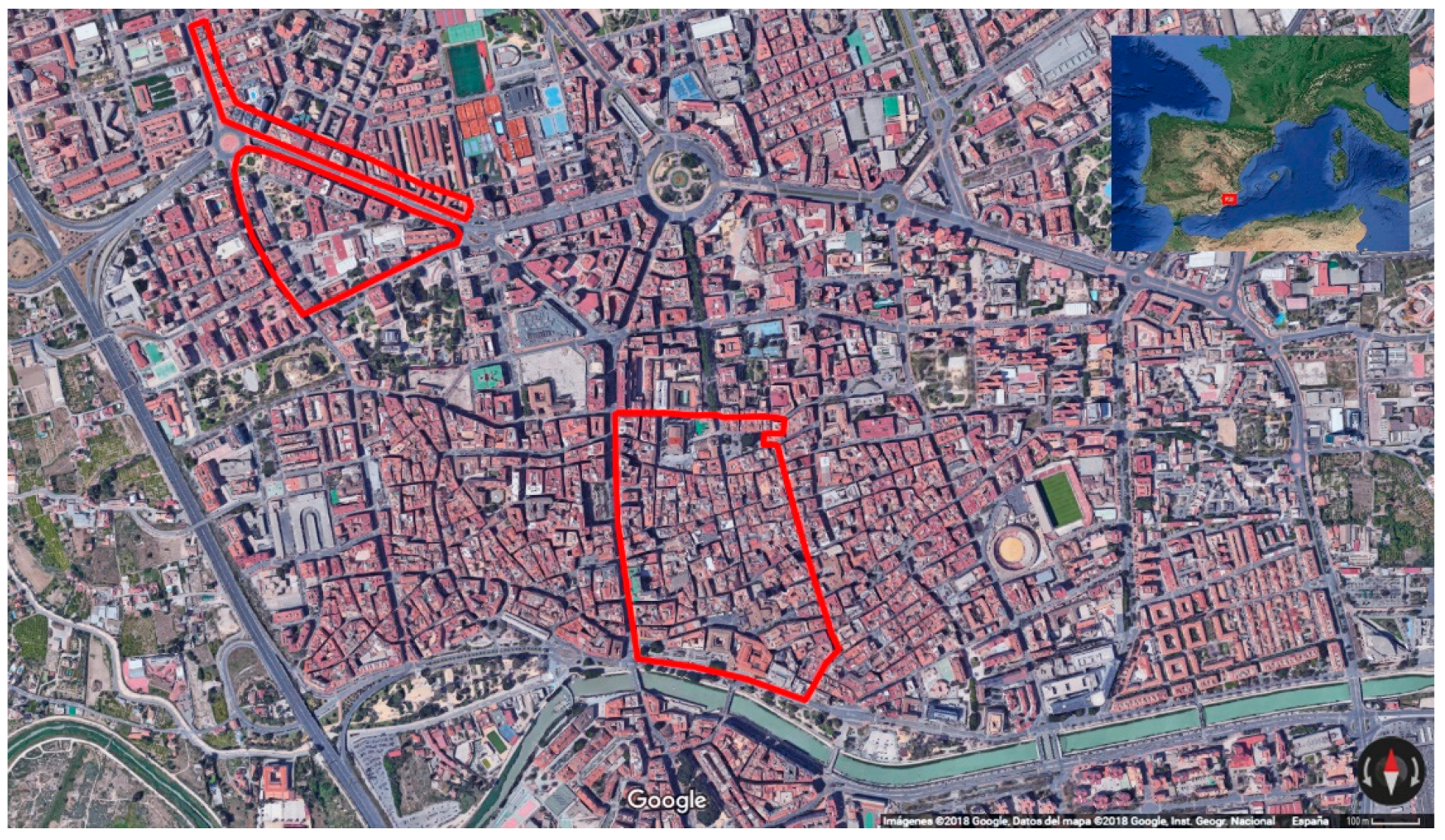
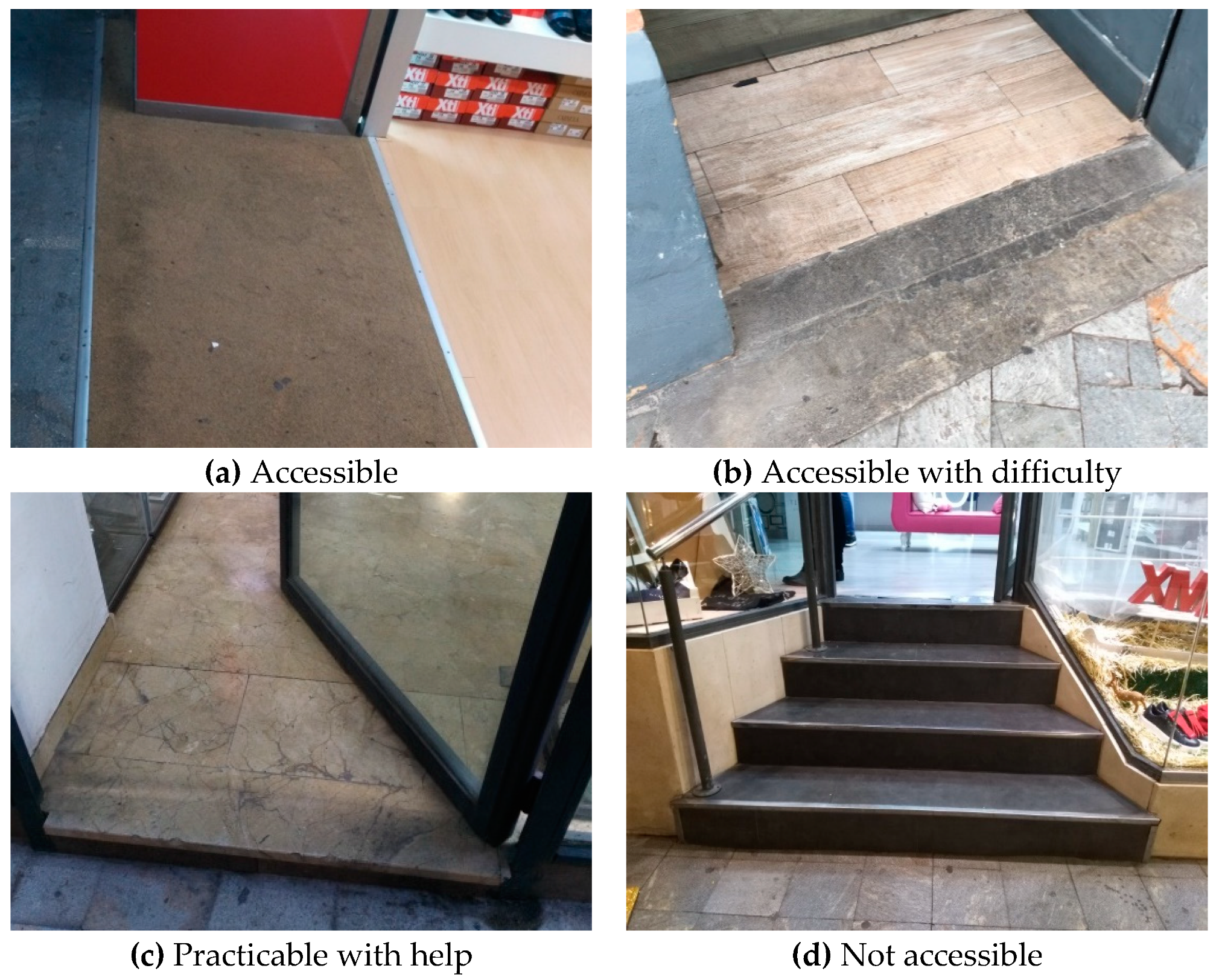
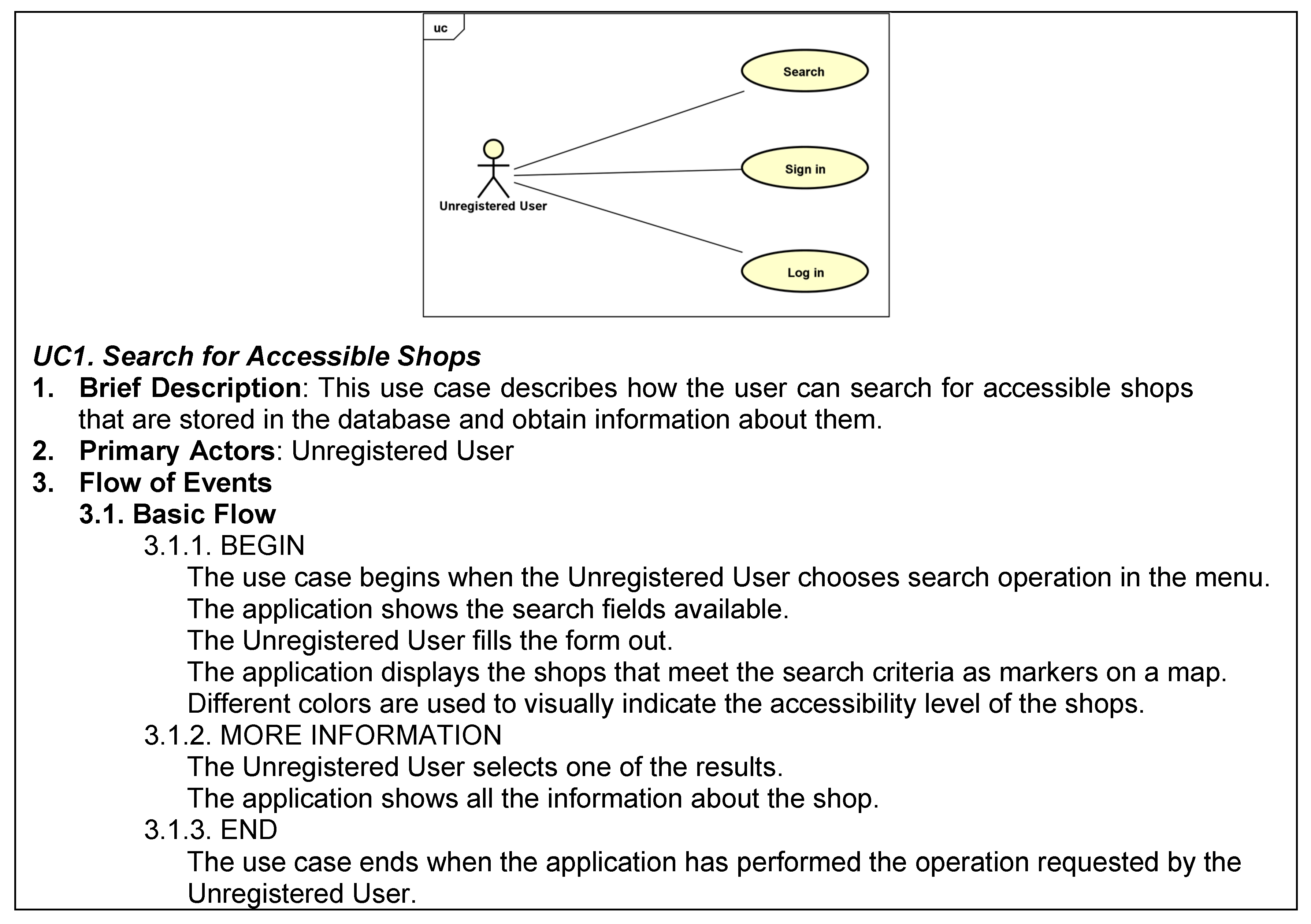
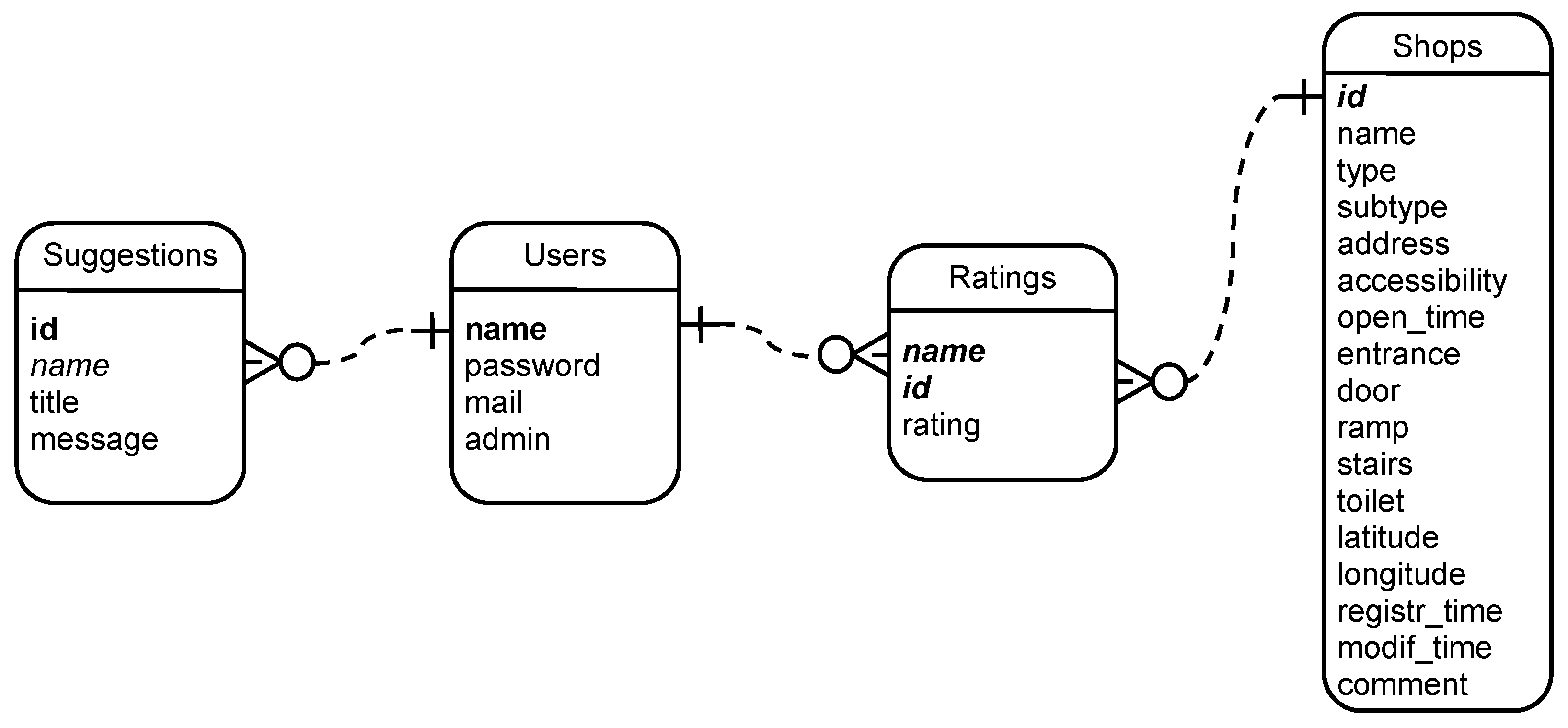
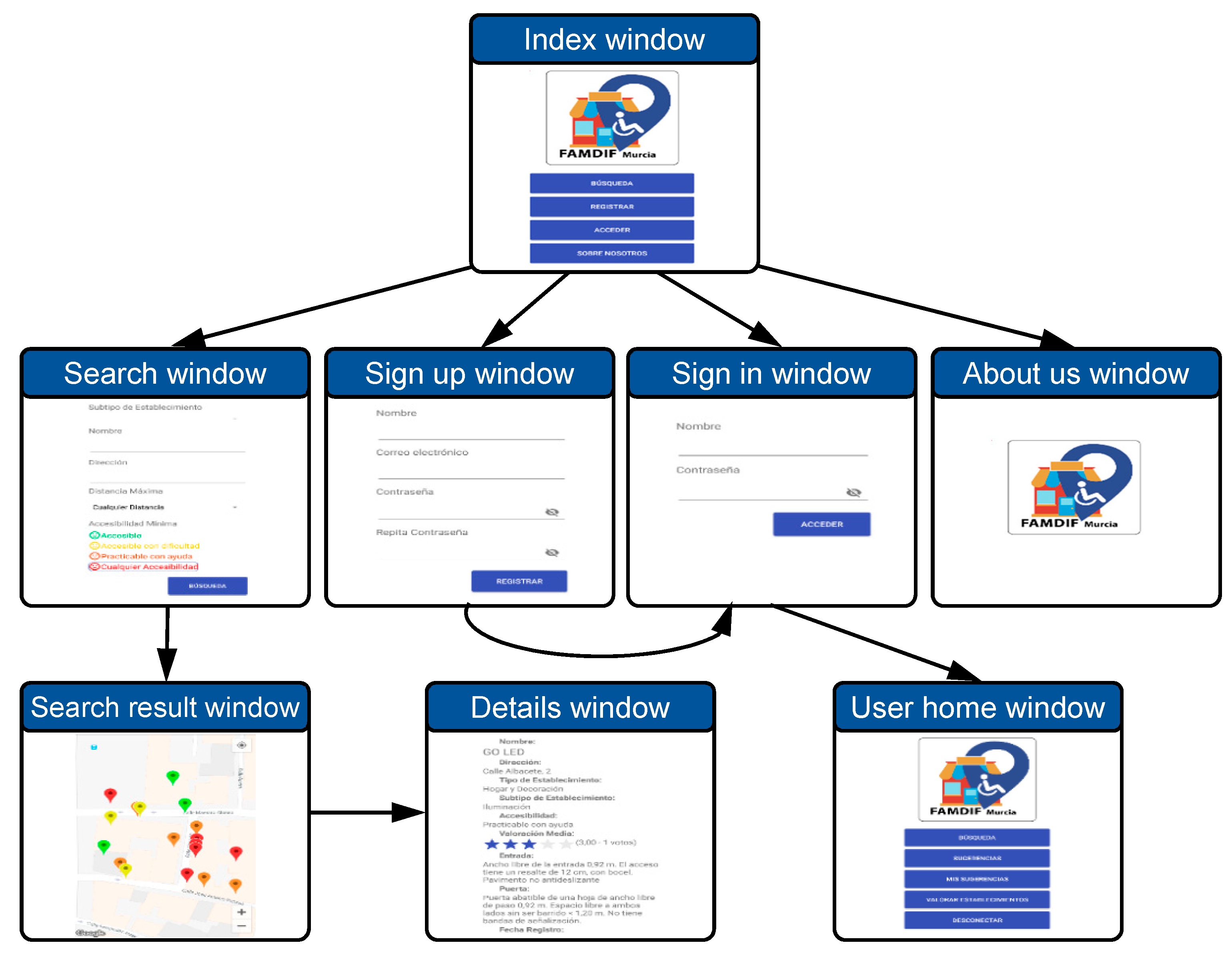
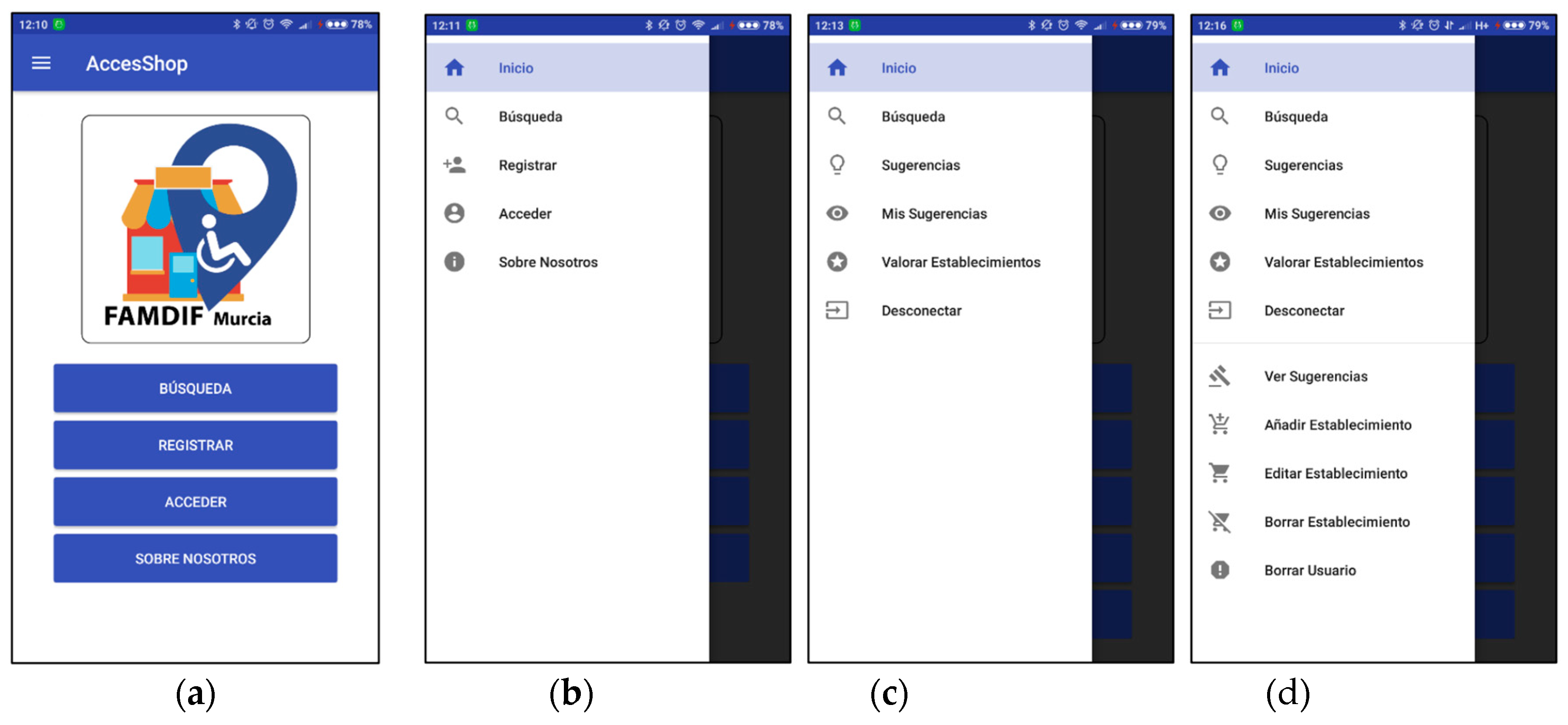
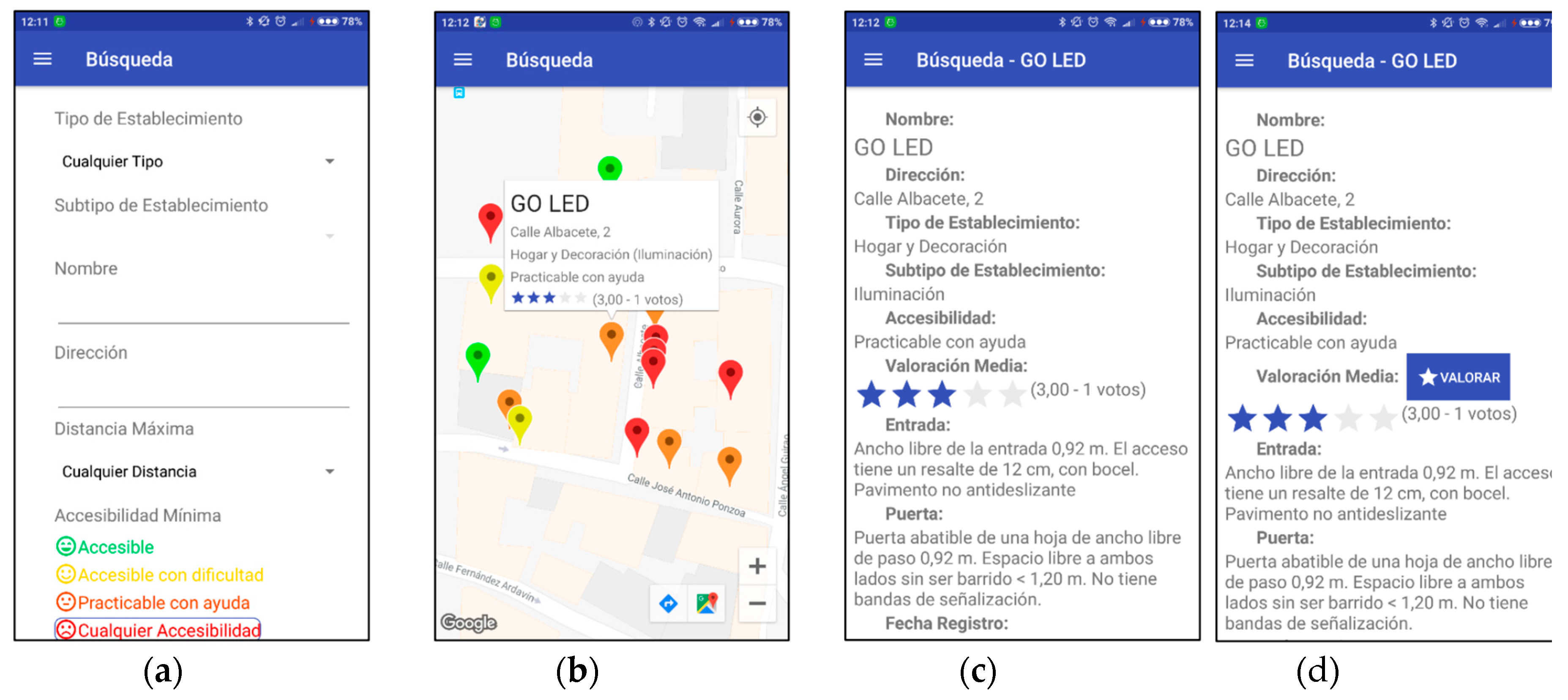
| Code | Name | Characteristics |
|---|---|---|
| A | Accessible | Access at street level, or through a ramp with maximum slope of 8%, or a step up to 1 cm. |
| B | Accessible with difficulty | Access with a ramp of 10% slope or less, or a step up to 5 cm overcome with a ramp of 25% slope or less. |
| C | Practicable with help | Access with a ramp with 12% slope or less, or a step up to 12 cm alone or with a ramp of 30% slope or less, or a step up to 3 cm round or beveled. |
| D | Not accessible | The rest of the cases. |
| Question | Evaluator A | Evaluator B |
|---|---|---|
| Did you find the shop of your interest? | 4 | 4 |
| Did you find shop alternatives? | 3 | 4 |
| Were the entrance of the shop as it appears in the app? | 4 | 4 |
| Were you able to find other information regarding the shop? | 5 | 4 |
| Was it easy to find a shop in the app? | 4 | 4 |
| Was it comfortable to search for information in the app? | 3 | 4 |
| Did you find all the information you need concerning access to the shop? | 2 | 3 |
| Were you able to register your profile? | 4 | 5 |
| Were you able to send suggestions? | 4 | 5 |
| Usability Principles by Dix | Evaluator A | Evaluator B |
|---|---|---|
| Predictability | 5 | 5 |
| Synthesizability | 4 | 4 |
| Familiarity | 4 | 4 |
| Generalizability | 4 | 5 |
| Consistency | 5 | 4 |
| Dialog initiative | 4 | 3 |
| Multi-threading | 2 | 3 |
| Task migratability | 3 | 3 |
| Substitutivity | 2 | 2 |
| Customizability | 1 | 1 |
| Observability | 3 | 4 |
| Recoverability | 4 | 4 |
| Responsiveness | 4 | 5 |
| Task conformance | 5 | 3 |
© 2019 by the authors. Licensee MDPI, Basel, Switzerland. This article is an open access article distributed under the terms and conditions of the Creative Commons Attribution (CC BY) license (http://creativecommons.org/licenses/by/4.0/).
Share and Cite
Mayordomo-Martínez, D.; Carrillo-de-Gea, J.M.; García-Mateos, G.; García-Berná, J.A.; Fernández-Alemán, J.L.; Rosero-López, S.; Parada-Sarabia, S.; García-Hernández, M. Sustainable Accessibility: A Mobile App for Helping People with Disabilities to Search Accessible Shops. Int. J. Environ. Res. Public Health 2019, 16, 620. https://doi.org/10.3390/ijerph16040620
Mayordomo-Martínez D, Carrillo-de-Gea JM, García-Mateos G, García-Berná JA, Fernández-Alemán JL, Rosero-López S, Parada-Sarabia S, García-Hernández M. Sustainable Accessibility: A Mobile App for Helping People with Disabilities to Search Accessible Shops. International Journal of Environmental Research and Public Health. 2019; 16(4):620. https://doi.org/10.3390/ijerph16040620
Chicago/Turabian StyleMayordomo-Martínez, Diego, Juan M. Carrillo-de-Gea, Ginés García-Mateos, José A. García-Berná, José Luis Fernández-Alemán, Saúl Rosero-López, Salvador Parada-Sarabia, and Manuel García-Hernández. 2019. "Sustainable Accessibility: A Mobile App for Helping People with Disabilities to Search Accessible Shops" International Journal of Environmental Research and Public Health 16, no. 4: 620. https://doi.org/10.3390/ijerph16040620
APA StyleMayordomo-Martínez, D., Carrillo-de-Gea, J. M., García-Mateos, G., García-Berná, J. A., Fernández-Alemán, J. L., Rosero-López, S., Parada-Sarabia, S., & García-Hernández, M. (2019). Sustainable Accessibility: A Mobile App for Helping People with Disabilities to Search Accessible Shops. International Journal of Environmental Research and Public Health, 16(4), 620. https://doi.org/10.3390/ijerph16040620








